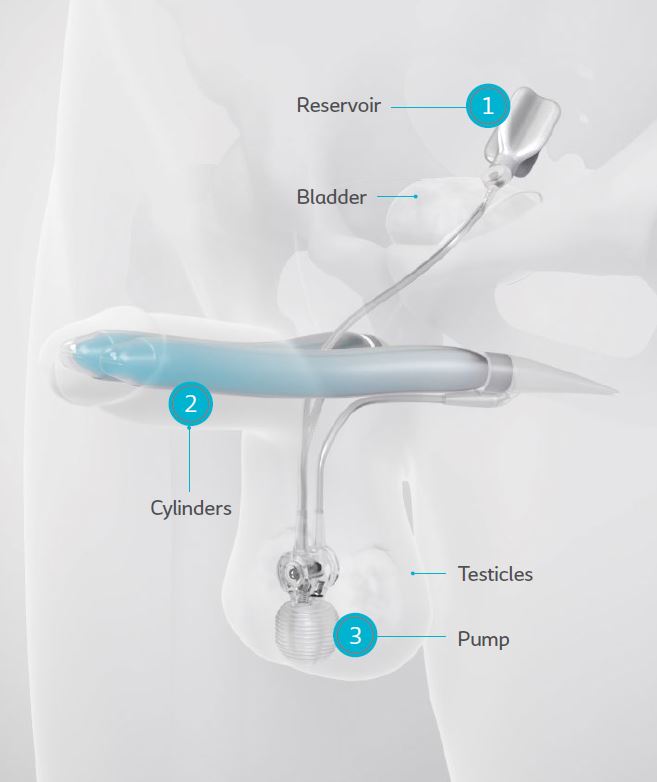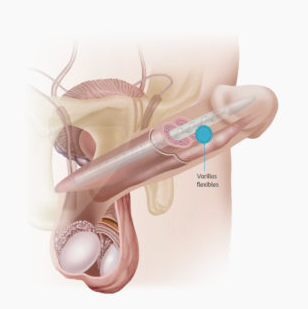
Penile Implants
What is a penile implant?
A penile implant is an erection assistance device that is designed to help a man get an erection and is completely hidden inside the body. It puts the man back in control of his body and can be used at any time. Unlike other treatments for erectile dysfunction (ED), a penile implant restores spontaneity and allows a man to get an erection without any planning or waiting.1
The device is implanted during a procedure through a small opening in the skin. Most men return home from the procedure on the same day and are able to resume sexual activity upon his doctor’s clearance, typically between 4-6 weeks.2
Why should I get a penile implant?
While pills are often offered as a first line therapy for ED, they often aren’t a long-term solution. 75% of patients treated for ED are initially treated with pills.3 Half of these patients will discontinue treatment in the first year due to reasons such as medication failure, cost or concerns about side effects or long-term safety.4 When these fail, some patients will move on to try another brand of pills, others will try penile injections and some will move on to a penile implant.
For patients who try oral medications and penile injections as second line treatments:


For some patients, when pills and injections no longer work, they move to a penile implant. For other patients, they may move to a penile implant right away.7 Penile implants have been shown to be a more cost-effective5 long-term ED treatment.6
To learn more about the costs of different ED treatments, click here.
Titan® Inflatable Penile Implant
The Titan inflatable penile implant was designed to mimic the look and performance of a natural erection.1 The Titan implant is made with a unique material called Bioflex®, which is a material that is safe for your body and is stronger than silicone.8 The Bioflex material was specifically engineered for penile implants to make them stronger9 and more durable8 than other penile implants available.
The Titan implant has three parts:
- A reservoir placed in the abdomen
- Two cylinders placed in the penis
- A pump placed in the scrotum
Titan features:
- Easy to use and activate1
- One-step deflation1
- Not visibly noticeable when flaccid1
- Acts and feels more like a natural erection1
- Maximizes the girth and rigidity of the penis9, 10

How does the Titan® implant work?
When you squeeze the pump in the scrotum, fluid moves from the reservoir into the cylinders in the shaft of the penis, creating an erection.
When you press the deflate button on the pump in the scrotum, the fluid moves out of the penis and back into the reservoir for a natural looking flaccid state.
View the following videos for a demonstration.
When you press the deflate button on the pump in the scrotum, the fluid moves out of the penis and back into the reservoir for a natural looking flaccid state.
View the following videos for a demonstration.
Reasons to consider a penile implant
A Discrete Treatment for ED
A penile implant is not noticeable when your penis is flaccid. Your partner won’t be able to tell you’ve had an implant to treat your ED unless you tell them.1
Patient Satisfaction Rates
Patients report a 98% satisfaction rate for the Titan penile implant. Partners of those with a Titan implant are also highly satisfied with a 96% satisfaction rate.1
Minimal Recovery Time
Every man is different, but a typical recovery time after a penile implant procedure is four to six weeks. After you’ve fully recovered, you can begin enjoying sex again.2
Cost Effective
Penile implants have been shown to be the most cost-effective ED treatment over a 10-year period.5
Insurance Coverage
Penile implants are prescribed by a physician and are generally covered by most insurance plans, including Medicare.11
Spontaneity
Penile implants give patients the ability to have an erection instantly and spontaneously, any time.1
Why does the Bioflex® material make a difference?
The Titan® Inflatable Penile Implant is made of the exclusive Bioflex® material, which gives the cylinders enhanced rigidity and girth compared to the competition’s products.
Durability
3 times more durable than the
competition8
The Titan® penile implant may enhance penetration performance for greater confidence in a variety of sexual positions so patients can feel uninhibited.8, 9, 12
Rigidity
3 times more rigid than the
competition9
Increased rigidity may enhance penetration performance during sexual intercourse with your partner.9
Girth
17% more circumference than the
competition10
The maximized girth of the Coloplast Titan® may lead to increased partner stimulation and satisfaction.14
What are malleable penile implants?
The Genesis® malleable penile implant consists of two firm but flexible rods that are placed into the shaft of the penis. There are no other parts to this implant. To have an erection, you simply hold the penis and move it into the desired position. When you are finished, you bend it back down to conceal it. The malleable penile implant can be a good option for men with limited dexterity.13
Genesis Implant Features
- Easy for you or your partner13
- Good option for men with limited dexterity13
- Because it says firm when not erect, may be more difficult to conceal in clothing1
Both the Titan® and Genesis® penile implants are totally concealed in the body, and give a man with ED the ability to have an erection – instantly, whenever the time is right, for however long he and his partner want. It helps put the man back in control and back to a normal life. Speak with a doctor to determine if a penile implant is right for you.

Find a qualified doctor who specializes in men’s sexual health
Use our Physician Finder to find a specialist in your area with the expertise needed to successfully treat your erectile dysfunction
Titan® and Titan® Touch Inflatable Penile Prosthesis – Important Safety Information
A penile implant, also called a penile prosthesis, is concealed entirely within the body to address erectile dysfunction (impotence). The implant requires some degree of manipulation before and after intercourse to make the penis erect or flaccid.
Indications
The Titan and Titan Touch Inflatable Penile Prosthesis is indicated for male patients suffering from erectile dysfunction (impotence) who are considered to be candidates for implantation of a penile prosthesis.
Contraindications
The Titan and Titan Touch Inflatable Penile Prosthesis is contraindicated in patients who have one or more of the following: (1) Patients with an active infection present anywhere in the body, especially urinary tract or genital infection. (2) Patients with a documented sensitivity to silicone. (3) Patients with unresolved problems affecting urination, such as an elevated residual urine volume secondary to bladder outlet obstruction or neurogenic bladder. (4) Patients unwilling to undergo any further surgery for device revision.
Warnings
Implantation of the device may make latent natural erections, as well as other interventional treatment options, impossible. Men with diabetes or spinal cord injuries, as well as immunocompromised patients, may have an increased risk of infection associated with a prosthesis. Implantation of a penile prosthesis may result in penile shortening, curvature or scarring.
Precautions
Removal of an implanted prosthesis without timely reimplantation of a new prosthesis may complicate subsequent reimplantation or may make it impossible. MRI quality may be compromised if the area of interest is in the exact same area or relatively close to the position of the Titan, and Titan Touch IPP. Be sure to consult with your physician. Patients should discuss all available treatment options and their risks and benefits with their physician. Health conditions which hamper sexual activity, such as severe chest pain (angina), may prevent successful use of this device. The prosthesis should not be implanted in patients who lack the manual dexterity or strength necessary to operate the device. Trauma to the pelvic or abdominal areas, such as impact injuries associated with sports (e.g., bicycle riding), can result in damage of the implanted device and/or surrounding tissues. This damage may result in the malfunction of the device and may necessitate surgical correction, including replacement of the device. The device may be used in the presence of Peyronie’s Disease.
Potential Complications
Penile implants are surgical solutions requiring a healing period that have risks associated with surgery such as scrotal swelling, auto-inflation, discomfort, angulation/curvature, swelling (edema), device malfunction, chronic pain, difficulty with ejaculation, transient urinary retention, fever, migration, patient dissatisfaction, infection at surgical site or wound, deflation, swelling of clotted blood or clear fluid (hematoma/seroma), wound leakage, bleeding, delayed wound healing, narrowing of the opening of the foreskin (phimosis), sensory loss, cylinder malfunction, formation of thick tissue (fibrous capsule formation), over/under inflation, erosion, scrotal reddening (erythema), genital change, and inguinal hernia.
This treatment is prescribed by your physician. Discuss the treatment options with your physician to understand the risks and benefits of the various options to determine if a penile implant is right for you.
Caution: Federal law (USA) restricts this device to sale by or on the order of a physician.
A penile implant, also called a penile prosthesis, is concealed entirely within the body to address erectile dysfunction (impotence). The implant requires some degree of manipulation before and after intercourse to make the penis erect or flaccid.
Indications
The Titan and Titan Touch Inflatable Penile Prosthesis is indicated for male patients suffering from erectile dysfunction (impotence) who are considered to be candidates for implantation of a penile prosthesis.
Contraindications
The Titan and Titan Touch Inflatable Penile Prosthesis is contraindicated in patients who have one or more of the following: (1) Patients with an active infection present anywhere in the body, especially urinary tract or genital infection. (2) Patients with a documented sensitivity to silicone. (3) Patients with unresolved problems affecting urination, such as an elevated residual urine volume secondary to bladder outlet obstruction or neurogenic bladder. (4) Patients unwilling to undergo any further surgery for device revision.
Warnings
Implantation of the device may make latent natural erections, as well as other interventional treatment options, impossible. Men with diabetes or spinal cord injuries, as well as immunocompromised patients, may have an increased risk of infection associated with a prosthesis. Implantation of a penile prosthesis may result in penile shortening, curvature or scarring.
Precautions
Removal of an implanted prosthesis without timely reimplantation of a new prosthesis may complicate subsequent reimplantation or may make it impossible. MRI quality may be compromised if the area of interest is in the exact same area or relatively close to the position of the Titan, and Titan Touch IPP. Be sure to consult with your physician. Patients should discuss all available treatment options and their risks and benefits with their physician. Health conditions which hamper sexual activity, such as severe chest pain (angina), may prevent successful use of this device. The prosthesis should not be implanted in patients who lack the manual dexterity or strength necessary to operate the device. Trauma to the pelvic or abdominal areas, such as impact injuries associated with sports (e.g., bicycle riding), can result in damage of the implanted device and/or surrounding tissues. This damage may result in the malfunction of the device and may necessitate surgical correction, including replacement of the device. The device may be used in the presence of Peyronie’s Disease.
Potential Complications
Penile implants are surgical solutions requiring a healing period that have risks associated with surgery such as scrotal swelling, auto-inflation, discomfort, angulation/curvature, swelling (edema), device malfunction, chronic pain, difficulty with ejaculation, transient urinary retention, fever, migration, patient dissatisfaction, infection at surgical site or wound, deflation, swelling of clotted blood or clear fluid (hematoma/seroma), wound leakage, bleeding, delayed wound healing, narrowing of the opening of the foreskin (phimosis), sensory loss, cylinder malfunction, formation of thick tissue (fibrous capsule formation), over/under inflation, erosion, scrotal reddening (erythema), genital change, and inguinal hernia.
This treatment is prescribed by your physician. Discuss the treatment options with your physician to understand the risks and benefits of the various options to determine if a penile implant is right for you.
Caution: Federal law (USA) restricts this device to sale by or on the order of a physician.
Genesis® Malleable Penile Prosthesis – Important Safety Information
A penile implant, also called a penile prosthesis, is concealed entirely within the body to address erectile dysfunction (impotence). The device is manually positioned to simulate an erect or flaccid penis.
Intended Purpose
The Genesis Malleable Penile Prosthesis is a flexible silicone elastomer device designed to be implanted into the penis for the management of erectile dysfunction (commonly known as impotence).
Indications
The prosthesis is designed for the management of erectile dysfunction (impotence) stemming from a variety of causes, including: epispadias (a rare birth defect located at the opening of the urethra), pelvic fracture; spinal cord injury or disease; prostatectomy; cystectomy; abdominal-perineal resection (surgical removal of the anus, rectum, and sigmoid colon); multiple sclerosis; diabetes mellitus; alcoholism; arteriosclerosis and hypertensive vascular disease; priapism (prolonged and painful erection of the penis); and Peyronie’s disease (curvature of the penis). The Prosthesis may also be used in selected patients with psychogenic impotence.
Contraindications
The Genesis Malleable Penile Prosthesis should not be used in: patients with an active infection present anywhere in the body, especially urinary tract or genital infection; patients with a documented sensitivity to silicone; and, patients with unresolved urinary problems, such as an elevated residual urine volume secondary to bladder outlet obstruction or neurogenic bladder.
Warnings
Implantation of a penile Prosthesis may make natural erections difficult to achieve. It may make some other interventional treatment options not possible. Implantation of a penile Prosthesis may result in penile shortening, curvature or scarring. Men with diabetes as well as immunocompromised patients, may have an increased risk of infection which could result in permanent damage to tissue/organs.
Consult with your physician if you are experiencing a change in rigidity or appearance of the erect penis. Replacement of the prosthesis may be necessary. If you have borderline bladder decompensation, an indwelling catheter, or enlargement of the prostate talk to your doctor.
Precautions
Patients should be informed that erections achieved with a malleable penile Prosthesis may differ from original erection (e.g. not of equal length or girth) compared to what was previously experienced with natural erections. Talk with your physician regarding realistic expectations. Health conditions which hamper sexual activity (e.g. severe angina) may prevent successful use of this device. Penile implants are not considered lifetime implants due to the inherent nature of mechanical devices. Trauma to the pelvic area, such as impact injuries associated with sports, can result in damage of the implanted device and/or surrounding tissues. This damage may result in the malfunction of the device and may necessitate surgical correction, including replacement of the device.
Potential Complications
Adverse events are known to occur with penile protheses procedures and implants; some may require revision surgery or removal of the implant. Adverse events following penile protheses implantation may be new (de novo), persistent, worsening, lasting for a short time (transient), or permanent.
Penile implants are surgical solutions requiring a healing period that have risks associated with surgery such as deformity, delayed / impaired / abnormal wound healing, injury to tissue or organs (erosion / extrusion / migration) resulting in damage or loss of tissue (necrosis), opening or tunnel between tissue or organs (fistula), allergic reaction or sensitivity to device, collection of blood or fluid outside of tissue or vessels (hematoma, seroma), bleeding or excessive bleeding (hemorrhage), infection, redness or swelling of tissue, irritation, penile implant moves (migration), penile tissue dying off (necrosis), pain/discomfort, inability to pull the foreskin forward over the tip of an uncircumcised penis (paraphimosis), inability to pull the foreskin back from the tip of an uncircumcised penis (acquired phimosis), perforation or injury of soft tissue (e.g., muscles, nerves, vessels), penile structures, or organs (e.g., urethra), scarring, difficulty during sexual activity, numbness or decreased sensation in penis, blockage or slowing of urine (urethral obstruction / occlusion), urinary tract infection, and difficulty emptying bladder.
The occurrence of these events may require one or more subsequent surgeries which may or may not always fully correct the complication.
This treatment is prescribed by your physician. Discuss the treatment options with your physician to understand the risks and benefits of the various options to determine if a penile implant is right for you.
Caution: Federal law (USA) restricts this device to sale by or on the order of a physician.
A penile implant, also called a penile prosthesis, is concealed entirely within the body to address erectile dysfunction (impotence). The device is manually positioned to simulate an erect or flaccid penis.
Intended Purpose
The Genesis Malleable Penile Prosthesis is a flexible silicone elastomer device designed to be implanted into the penis for the management of erectile dysfunction (commonly known as impotence).
Indications
The prosthesis is designed for the management of erectile dysfunction (impotence) stemming from a variety of causes, including: epispadias (a rare birth defect located at the opening of the urethra), pelvic fracture; spinal cord injury or disease; prostatectomy; cystectomy; abdominal-perineal resection (surgical removal of the anus, rectum, and sigmoid colon); multiple sclerosis; diabetes mellitus; alcoholism; arteriosclerosis and hypertensive vascular disease; priapism (prolonged and painful erection of the penis); and Peyronie’s disease (curvature of the penis). The Prosthesis may also be used in selected patients with psychogenic impotence.
Contraindications
The Genesis Malleable Penile Prosthesis should not be used in: patients with an active infection present anywhere in the body, especially urinary tract or genital infection; patients with a documented sensitivity to silicone; and, patients with unresolved urinary problems, such as an elevated residual urine volume secondary to bladder outlet obstruction or neurogenic bladder.
Warnings
Implantation of a penile Prosthesis may make natural erections difficult to achieve. It may make some other interventional treatment options not possible. Implantation of a penile Prosthesis may result in penile shortening, curvature or scarring. Men with diabetes as well as immunocompromised patients, may have an increased risk of infection which could result in permanent damage to tissue/organs.
Consult with your physician if you are experiencing a change in rigidity or appearance of the erect penis. Replacement of the prosthesis may be necessary. If you have borderline bladder decompensation, an indwelling catheter, or enlargement of the prostate talk to your doctor.
Precautions
Patients should be informed that erections achieved with a malleable penile Prosthesis may differ from original erection (e.g. not of equal length or girth) compared to what was previously experienced with natural erections. Talk with your physician regarding realistic expectations. Health conditions which hamper sexual activity (e.g. severe angina) may prevent successful use of this device. Penile implants are not considered lifetime implants due to the inherent nature of mechanical devices. Trauma to the pelvic area, such as impact injuries associated with sports, can result in damage of the implanted device and/or surrounding tissues. This damage may result in the malfunction of the device and may necessitate surgical correction, including replacement of the device.
Potential Complications
Adverse events are known to occur with penile protheses procedures and implants; some may require revision surgery or removal of the implant. Adverse events following penile protheses implantation may be new (de novo), persistent, worsening, lasting for a short time (transient), or permanent.
Penile implants are surgical solutions requiring a healing period that have risks associated with surgery such as deformity, delayed / impaired / abnormal wound healing, injury to tissue or organs (erosion / extrusion / migration) resulting in damage or loss of tissue (necrosis), opening or tunnel between tissue or organs (fistula), allergic reaction or sensitivity to device, collection of blood or fluid outside of tissue or vessels (hematoma, seroma), bleeding or excessive bleeding (hemorrhage), infection, redness or swelling of tissue, irritation, penile implant moves (migration), penile tissue dying off (necrosis), pain/discomfort, inability to pull the foreskin forward over the tip of an uncircumcised penis (paraphimosis), inability to pull the foreskin back from the tip of an uncircumcised penis (acquired phimosis), perforation or injury of soft tissue (e.g., muscles, nerves, vessels), penile structures, or organs (e.g., urethra), scarring, difficulty during sexual activity, numbness or decreased sensation in penis, blockage or slowing of urine (urethral obstruction / occlusion), urinary tract infection, and difficulty emptying bladder.
The occurrence of these events may require one or more subsequent surgeries which may or may not always fully correct the complication.
This treatment is prescribed by your physician. Discuss the treatment options with your physician to understand the risks and benefits of the various options to determine if a penile implant is right for you.
Caution: Federal law (USA) restricts this device to sale by or on the order of a physician.
References
- Data on file at Coloplast
- Treatment for Erectile Dysfunction. NIH: National Institute of Diabetes and Digestive and Kidney Diseases. https://www.niddk.nih.gov/health-information/urologic-diseases/erectile-dysfunction/treatment. Accessed March 2023.
- Frederick LR, Cakir OO, Arora H, Helfand BT, McVary KT. Undertreatment of erectile dysfunction: claims analysis of 6.2 million patients. J Sex Med. 2014 Oct;11(10):2546-53.
- Jannini EA, Droupy S. Needs and Expectations of Patients with Erectile Dysfunction: An Update on Pharmacological Innovations in Phosphodiesterase Type 5 Inhibition with Focus on Sildenafil. Sex Med. 2019 Mar;7(1):1-10.
- Moses RA, Anderson RE, Kim J, Keihani S, Craig JR, Myers JB, Lenherr SM, Brant WO, Hotaling JM. Erectile dysfunction management after failed phosphodiesterase-5-inhibitor trial: a cost-effectiveness analysis. Transl Androl Urol. 2019 Aug;8(4):387-394.
- Miller LE, Khera M, Bhattacharyya S, Patel M, Nitschelm K, Burnett AL. Long-Term Survival Rates of Inflatable Penile Prostheses: Systematic Review and Meta-Analysis. Urology. 2022 Aug;166:6-10.
- Burnett AL, Nehra A, Breau RH, Culkin DJ, Faraday MM, Hakim LS, Heidelbaugh J, Khera M, McVary KT, Miner MM, Nelson CJ, Sadeghi-Nejad H, Seftel AD, Shindel AW. Erectile Dysfunction: AUA Guideline. J Urol. 2018 Sep;200(3):633-641.
- Pritchard, Charles, MD, et al. “Comparison of AMS 700 CX and Coloplast Titan Inflatable Penile Prosthesis Cylinders Subjected to In-Vitro Cyclic Buckling.” Sexual Medicine Society of North America Fall Meeting, Poster 111, 2008.
- Scovell JM, Ge L, Barrera EV, Wilson SK, Carrion RE, Hakky TS. Longitudinal and Horizontal Load Testing of Inflatable Penile Implant Cylinders of Two Manufacturers: An Ex Vivo Demonstration of Inflated Rigidity. J Sex Med. 2016 Nov;13(11):1750-1757.
- Pescatori ES, Goldstein I. Intraluminal device pressures in 3-piece inflatable penile prostheses: the “pathophysiology” of mechanical malfunction. J Urol. 1993 Feb;149(2):295-300.
- Does Medicare Cover Penile Implants? Medicare.org. https://www.medicare.org/articles/does-medicare-cover-penile-implants/. Accessed October 2022.
- Fernandez-Crespo RE, Buscaino K, Carrion R. Optimizing Outcomes in Penile Implant Surgery. Urol Clin North Am. 2021 Nov;48(4):527-542. doi: 10.1016/j.ucl.2021.06.010. PMID: 34602173.
- Malleable (Semi-Rigid) Penile Prosthesis (MPP). Habous, Mohamad. The Journal of Sexual Medicine, Volume 12, Issue 10, 1984 – 1988.
- Prause N, Park J, Leung S, Miller G. Women’s Preferences for Penis Size: A New Research Method Using Selection among 3D Models. PLoS One. 2015 Sep 2;10(9):e0133079. doi: 10.1371/journal.pone.0133079.
